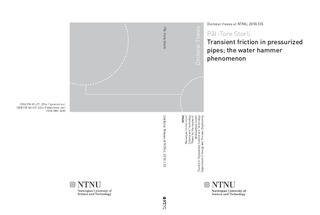| dc.contributor.author | Storli, Pål-Tore | nb_NO |
| dc.date.accessioned | 2014-12-19T11:45:52Z | |
| dc.date.available | 2014-12-19T11:45:52Z | |
| dc.date.created | 2010-10-19 | nb_NO |
| dc.date.issued | 2010 | nb_NO |
| dc.identifier | 357747 | nb_NO |
| dc.identifier.isbn | 978-82-471-2234-1 (printed ver.) | nb_NO |
| dc.identifier.isbn | 978-82-471-2236-5 (electronic ver.) | nb_NO |
| dc.identifier.uri | http://hdl.handle.net/11250/234111 | |
| dc.description.abstract | The friction in non-stationary flow is an intriguing and interesting phenomenon. Many types of non-stationary flow exist, and the friction involved in these flows is in many cases significantly different from the steady state friction for the same instantaneous flow. Knowledge of this friction is important for many different fields of engineering, such as dimensioning of pipeline systems, operation and maintenance of pipeline systems, water quality monitoring and stability of the operation of governed components in pipeline systems.
Unsteady fluid flow where friction is included is not easily computable, at least not if detailed transient information is desirable for long duration simulations. The complexity in phenomena involved in transients in fluid flows is huge, and simplifications justified for some transient flows might very well be highly erroneous for others types of flows. A general and comprehensive model for the friction involved in transient flow is highly desirable, but unfortunately the models that are closest to meeting this desire is not practically applicable due to the computational demands of the models. One-dimensional models are simple and applicable from a practical point of view, but their accuracy has traditionally been limited. One-dimensional models have been able to simulate maximum peak pressures for single pipelines, but not the general dynamics of the pressure-time history with correct dampening. This is a problem in pipeline systems because dimensioning pressures are not necessarily only dependent on peak pressure values but also the decay and build-up of the pressure-time history.
The work presented in this thesis is using a novel methodology in order to find coefficients that highly improve the accuracy of one particular one-dimensional unsteady friction model for the case of a sudden closure of a downstream valve for an initial flow at low Reynolds number. The methodology in finding these coefficients is based on the unique periodicity of local accelerations that occur due to the pressure wave that travels between boundaries and the physically founded weighting function used in the Convolution Based models. This cause the two coefficients used to become position dependent, thus curving the characteristic lines in the Method of Characteristics solution scheme. The improvement is not proven general, but the methodology represents an improvement of simulated pressure traces that is significant. The approach in finding these coefficients is based on physical considerations, although the methodology itself must be classified as empirical. | nb_NO |
| dc.language | eng | nb_NO |
| dc.publisher | Norges teknisk-naturvitenskapelige universitet, Fakultet for ingeniørvitenskap og teknologi, Institutt for energi- og prosessteknikk | nb_NO |
| dc.relation.ispartofseries | Doktoravhandlinger ved NTNU, 1503-8181; 2010:135 | nb_NO |
| dc.relation.haspart | Storli, Pål-Tore; Nielsen, Torbjørn K.. Transient friction in pressurized pipes; a two-coefficient instantaneous acceleration based model. . | nb_NO |
| dc.relation.haspart | Storli, Pål-Tore; Nielsen, Torbjørn K.. Transient friction in pressurized pipes; investigation ofthe EIT model based on curved coefficient approach in MIAB model. . | nb_NO |
| dc.title | Transient friction in pressurized pipes; the water hammer phenomenon | nb_NO |
| dc.type | Doctoral thesis | nb_NO |
| dc.contributor.department | Norges teknisk-naturvitenskapelige universitet, Fakultet for ingeniørvitenskap og teknologi, Institutt for energi- og prosessteknikk | nb_NO |
| dc.description.degree | PhD i energi- og prosessteknikk | nb_NO |
| dc.description.degree | PhD in Energy and Process Engineering | en_GB |

